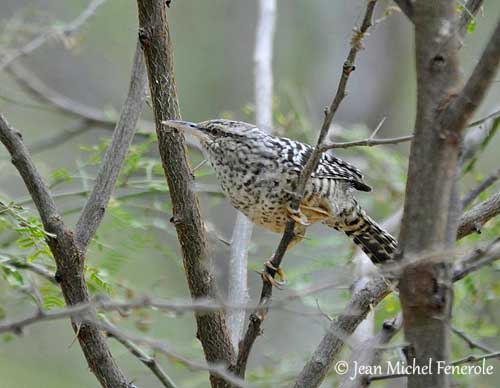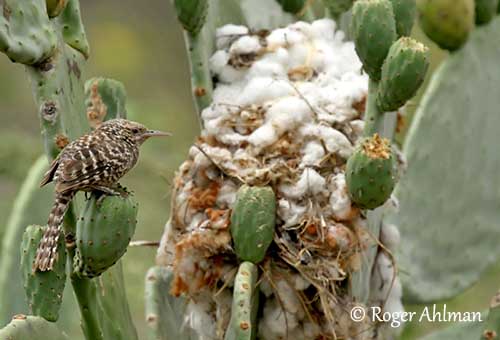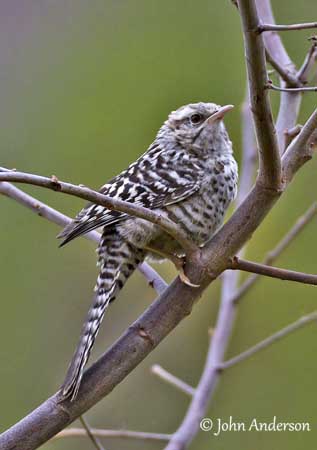
Fr: Troglodyte fascié
All : Bindenzaunkönig
Esp : Ratona Franjeada
Esp (Ecuador) : Chochín ondeado
Ital : Scricciolo fasciato
Nd: Zebrawinterkoning
Sd: Bandad gärdsmyg
Photographers:
Roger Ahlman
Pbase Galleries Peru and Ecuador
John Anderson
John Anderson Photo Galleries
Jean Michel Fenerole
Photos d’Oiseaux du monde
Text by Nicole Bouglouan
Sources:
HANDBOOK OF THE BIRDS OF THE WORLD Vol 10 by Josep del Hoyo-Andrew Elliott-David Christie - Lynx Edicions - ISBN: 8487334725
BIRDS OF SOUTH AMERICA – Passerines - by Robert S. Ridgely and Guy Tudor – HELM Field Guides – ISBN: 9781408113424
WRENS, DIPPERS AND THRASHERS by Brewer David – illustrated by Barry Kent Mackay- Yale University Press - ISBN: 0300090595
BirdLife International (BirdLife International)
Fasciated Wren
Campylorhynchus fasciatus
Passeriforme Order – Troglodytidae Family
BIOMETRICS:
Length : 19 cm
DESCRIPTION:
Like other Campylorhyncus wrens, the Fasciated Wren is noisy and social, living in small groups at all levels in trees and shrubs.
The adult male of nominate race has blackish, grey and white plumage.
On the upperparts, back and rump are barred whitish, whereas shoulders are speckled white. On the upperwing, primaries, secondaries and coverts are heavily barred black and white. The long tail is blackish-brown, conspicuously barred white.
On the underparts, the chin is white streaked dark grey. Breast and belly are whitish and heavily mottled blackish-grey, whereas flanks are barred blackish-grey. Thighs and vent are barred dull buff and dull blackish-brown.
On the head, the black crown is speckled grey and the ear-coverts are mottled grey-buff. The greyish-white supercilium often shows irregular shape. We can see a blackish eye-stripe from lores, through the eye to ear-coverts.
The bill is relatively long and thin, dark grey to dark brown above, and greyish-horn below. The eyes are red-brown or paler brown. Legs and feet are dark brown or dull yellowish.

Both sexes are similar.
The juvenile has indistinct markings on the underparts. The eyes are slate grey. The crown is darker than in adults.
We can find two subspecies:
C.f. fasciatus is found in arid coastal regions of Peru, from NW Lima N to Piura.
C.f. pallescens is found in SW and S Ecuador, S to N Peru. This one is paler, with less pronounced markings on underparts. The whitish supercilium is wider with dusky edges. The bill is shorter.
VOICE: SOUNDS BY XENO-CANTO
The Fasciated Wren’s calls are sharp “chak” and other harsh variants.
The loud, rhythmic song is a repetition of harsh scratchy phrase, often interspersed with series of more gurgling notes.
The song is often given as a duet. When the birds are in groups, one bird may often perform duet with a bird of the opposite sex.
HABITAT:
The Fasciated Wren is found both in arid and semi-arid areas such as thorny scrublands including disturbed areas at the edges of human activities (gardens, farmhouses). It also frequents citrus orchards.
In Ecuador, it is found in more humid habitat.
This species is visible from sea-level up to 1500 metres of elevation, and locally up to 2500 metres.
RANGE:
See above in “subspecies”
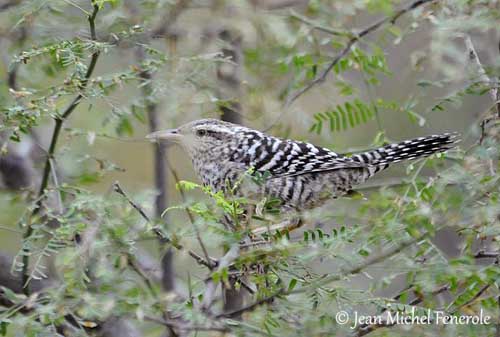
BEHAVIOUR:
The Fasciated Wren feeds primarily on invertebrates and may take some plant matter.
They forage in groups in bushes, sometimes on the ground, but also on roofs of huts and farmhouses.
This species is noisy and conspicuous, often seen in extended family groups. They roost communally in nests.
During the breeding season, the Fasciated Wren appears to have well-developed co-operative breeding system. They breed in groups of up to ten birds for each breeding pair. The young of one year remain in order to assist their parents with nesting duties in the next year.
Wrens can be aggressive in territorial defence and during the breeding season. They fan the wings and drop the partially spread tail while the bill is pointed at the intruder, rival or predator.
Two individuals can fly vertically upwards over short distance, and flap their wings into each other. They may grasp their feet and peck at each other. These displays can be directed against other bird species, even larger ones.
The Fasciated Wren is sedentary in its range, but the young females may perform local dispersal. The young males remain with the group and gradually attain breeding status and sexual maturity.
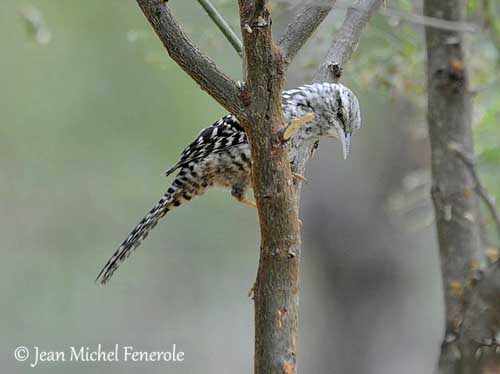
FLIGHT:
The Fasciated Wren performs short flights in dense vegetation.
REPRODUCTION:
The breeding season occurs between May and August.
The Fasciated Wren breeds mainly in co-operative groups and more rarely as solitary nester. There are one dominant breeding pair and several individuals, up to ten. The young of the year remain in the territory to assist their parents at nest in the next year.
The nest is a domed structure with side entrance. It is made with grass and lined with feathers. This structure can be built in citrus or mesquite (Proposis), and also in tall cactus. This wren may also use old mud-oven nests of Furnarius species.
The female lays 3-4 eggs. Incubation lasts about 17 days. There is no information on fledging period.
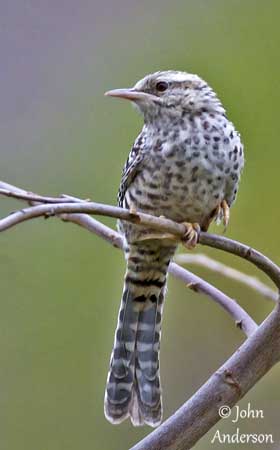
DIET:
The Fasciated Wren feeds mainly on invertebrates and may consume some plant matter.
PROTECTION / THREATS / STATUS:
The Fasciated Wren is common in its range. This species is able to adapt to modified habitats if sufficient bushes are left.
The species is not currently threatened.
